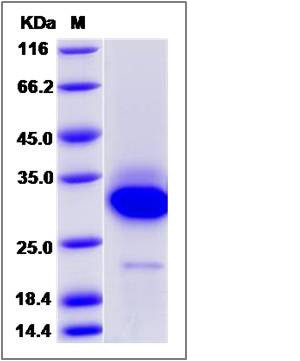Canine CD40 / TNFRSF5 Protein
CD40, TNFRSF5
- 100ug (NPP1832) Please inquiry
| Catalog Number | P70105-DCCH |
|---|---|
| Organism Species | Canine |
| Host | Human Cells |
| Synonyms | CD40, TNFRSF5 |
| Molecular Weight | The recombinant canine CD40 is a disulfide-linked homodimer. The reduced monomer comprises 181 amino acids and has a predicted molecular mass of 19.9 kDa. The apparent molecular mass of the protein is approximately 28-32 kDa in SDS-PAGE under reducing conditions. |
| predicted N | Glu 21 |
| SDS-PAGE |  |
| Purity | > 95 % as determined by SDS-PAGE |
| Protein Construction | A DNA sequence encoding the canine CD40 (Q7YRL5) (Met1-Ala194) was expressed with six amino acids (LEVLFQ) at the C-terminus. |
| Bio-activity | |
| Research Area | Immunology |Innate Immunity |Cytokine |TNF Superfamily |Processes Regulated by TNF Superfamily Members |Regulation of T Cell Co-stimulation by TNF Superfamily Members | |
| Formulation | Lyophilized from sterile PBS, pH 7.4. 1. Normally 5 % - 8 % trehalose and mannitol are added as protectants before lyophilization. Specific concentrations are included in the hardcopy of COA. |
| Background | CD40, also known as TNFRSF5, is a member of the TNF receptor superfamily which are single transmembrane-spanning glycoproteins. CD40 protein plays an essential role in mediating a broad variety of immune and inflammatory responses including T cell-dependent immunoglobulin class switching, memory B cell development, and germinal center formation. CD40 protein is expressed in B cells, dendritic cells, macrophages, endothelial cells, and several tumor cell lines. Defects in CD40 result in hyper-IgM immunodeficiency type 3 (HIGM3). In addition, CD40/CD40L interaction is found to be necessary for amyloid-beta-induced microglial activation, and thus is thought to be an early event in Alzheimer disease pathogenesis. |
| Reference |
